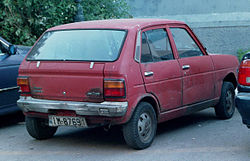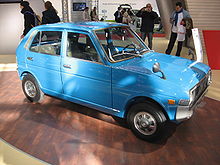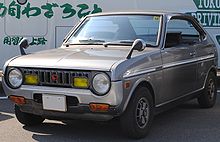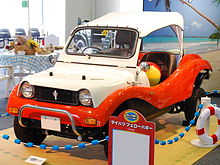- Daihatsu Fellow Max
-
The Daihatsu Fellow Max is a small Japanese automobile in the Kei car class. Originally introduced as the Daihatsu Fellow, the name was partially retained for the Max Cuore (1977) and then again for the 2000 Daihatsu Max.
Contents
360cc era
Fellow
On 9 November 1966, Daihatsu introduced the Fellow, also known as Daihatsu 360 in export markets. Originally only available in DeLuxe and Super DeLuxe equipment levels, a Standard version joined in February 1967. Also available with a wagon body (Fellow Van), as a mini-pickup truck and as a panel van from June 1967, the L37 was conventionally built with a front-mounted engine and rear wheel drive. It used a 23 hp iteration of the 356 cc, water-cooled two-cylinder two-stroke "ZM" engine already seen in the Hijet and a four-speed manual transmission.[1] The self-lubricating (Oil-Matic) little engine weighed only 58 kg (128 lb).[2] The Fellow was the first Japanese car to be equipped with rectangular headlights.
As a result of Honda's 31 hp N360 being introduced early in 1967, a Kei-car horsepower war broke out. Daihatsu's response, the Fellow SS, was presented at the 1967 Tokyo Motor Show in October but did not go on sale until June the next year.[3] A LeMans-style sportscar prototype, the "P-5" with the SS engine was shown alongside. The 32 hp "SS" could do the 400 meter sprint in 21.2 seconds.
The Fellow also received a slight facelift in October 1967, with a new dashboard and steering wheel most noticeable. Another minor change came in January 1969, with a fixed drivers' side headrest and seatbelts installed because of new safety regulations.[3] In July, along with what was literally a facelift (the front bumper was now mounted higher), the lesser engine's output increased to 26 hp and a comparatively luxurious "Custom" version was added at the top of the lineup.[4] The size of the taillights also increased somewhat.
Daihatsu Fellow L37 Data Version Engine Power Torque Dimensions (mm) Weight
(kg)Top speed
(km/h)Gears Production Note hp kW @ rpm kgm Nm @ rpm length width height wb begin end Std, DX, SDX[5] Water-cooled 356 cc ZM two-cycle two-cylinder 23 17 5,000 3.5 34.3 4,000 2,990 1,285 1,350 1,990 515 100 4MT 66.11 69.07 Std. from 67.02 Std, DX, SDX, Custom[6] 26 19 5,500 3.5 34.3 4,500 495 110 69.07 70.04 facelifted version SS[3] 32 23.5 6,500 3.8 37.3 5,000 [7]115 68.06 70.04 Van Std, SDX[8]
(Pickup)23 17 5,000 3.5 34.3 4,000 2,995 1,295 1,430
(1,420)1,940 545
(500)[9]85 67.06 69.07 300 kg (350) payload Van Std, SDX
(Pickup)26 19 5,500 3.5 34.3 4,500 n/a 69.07 70.07 Fellow Max
In April 1970, the front-wheel drive L38 Daihatsu Fellow Max was introduced to replace the rear-wheel drive Fellow. Originally only available as a two-door sedan and three-door van, a sporty hardtop coupé with a lower roofline and a somewhat baroque front-end treatment was added in August 1971. SL and GXL Hardtops received standard front disc brakes. In October 1972 a four-door version appeared; it was the only four-door Kei car at the time of its introduction. Dimensions were 2,995 x 1,295 mm as dictated by the Kei car regulations, although the wheelbase was stretched by 100 mm to 2,090 mm. The engine was a 360 cc two-cylinder two-stroke ("ZM"), offering 33 PS at the time of introduction.[10] In July of 1970 the SS version appeared, featuring a twin-carb, 40 PS (SAE) version of the ZM engine - a specific output of over 112 PS per litre. Top speed was 120 km/h, compared to 115 km/h (75 and 71 mph) for the lesser versions. In October 1972, for the '73 model year, engine outputs dropped somewhat, to 31 and 37 PS respectively to lower fuel consumption and meet new, more stringent emissions standards.[11]
As if the existing four bodystyles didn't suffice, a beach buggy version was introduced simultaneously. While highly prized by collectors today, the Buggy only sold about 100 examples and was only available for a single model year. The 440 kg Fellow Buggy was actually not a "real" Fellow, as it was built on a Hijet chassis, with fibre-reinforced plastic bodywork.[12] The Buggy also used the Hijet's lower powered (26 PS/19 kW) engine, providing a top speed of 95 km/h (59 mph).[13]
The Fellow Max received a steady stream of facelifts during its existence. It underwent minor changes in March 1971 (new grille, dash modifications), March 1972 (new dash, round headlights and a new bonnet with longitudinal creases), May 1973 (changes to the fenders and new bumpers that fitted into the bodywork, and another new bonnet) and in October 1973 (new safety equipment). In February 1975 the bumpers were modified again, to allow for the fitment of new, larger license plates. The grille and front bumper arrangement was changed yet again. At the same time the interior saw some changes and the powerful twin-carb model was dropped as it wouldn't pass new emissions regulations. In May 1976 the car underwent more thorough changes as new Kei car regulations were introduced. This also marked the end of the Hardtop versions, which anyhow had lost relevance once the twin-carb engine was discontinued.
550cc era
Daihatsu Fellow Max/Max Cuore 
Also called Daihatsu Max 550
Daihatsu CuoreProduction 1976-1980 Successor Daihatsu Cuore Class Kei car Body style 2/4-door sedan
3-door vanLayout Front engine, front-wheel drive Platform L40, L45 Engine 547 cc AB10 SOHC I2 Transmission 4-speed manual Wheelbase 2,090 mm Length 3,120-3,165 mm Width 1,305-1,395 mm Height 1,320 mm Kerb weight 535-565 kg In May 1976, responding to a change in the Kei car regulations, Daihatsu increased the Fellow Max' engine size to 547 cc and gave it a new chassis code (L40/L40V). The name remained, although the "Fellow" portion received less prominence and some marketing material simply referred to the car as the "Max 550". The new "AB10" four-stroke two-cylinder engine replaced the old two-cycle "ZM". This, developed with help from Toyota, was an overhead camshaft design (belt-driven) which also featured balance axles to smoothen the inherently imbalanced two-cylinder design.[14] The AB10 engine was also briefly sold to Suzuki for use in the four-stroke version of their Fronte 7-S. The cleaner four-stroke offered less power than the revvy 360, down to 28 PS (21 kW) at 6,000 rpm. Torque increased somewhat, to 3.9 kg·m (38 N·m) at a significantly lower 3,500 rpm.
New bumpers meant length and width were up marginally to 3,120 mm (122.8 in) and 1,305 mm (51.4 in).[15] Claimed top speed was 110 km/h (68 mph), somewhat lower than that of the 360.[16] With Honda withdrawing from the Kei market segment, Daihatsu became the only maker to offer a Kei car featuring front-wheel drive.[14] The Van used the front end and front doors from the two-door Max, but with a more square-rigged rear end featuring a split tailgate (divided horizontally) and a folding rear seat which allowed for a flat loading floor.
Max Cuore
In July of 1977 the name was changed to Max Cuore (chassis code L45, although Vans remained L40V). The new name also heralded a wider body shell (up to 1,395 mm/54.9 in) which also increased the length to 3,160 mm for the sedan[15] and 3,165 mm for the wagon. By March, 1979 the car was renamed Daihatsu Cuore (though it was still badged Max Cuore), along with a power upgrade to 31 PS (23 kW) at 6,000 rpm. Torque increased to 4.2 kg·m (41 N·m) for the engine, which now featured the DECS (Daihatsu Economical Clean-up System) emissions control system to meet the stricter 1978 (53年) emissions standards. In Europe, the car was simply called Daihatsu Cuore from 1977 on. 1980 saw the introduction of the parallel commercial series Daihatsu Mira, while the name "Max" disappeared entirely from the Cuore.
In Japan, the 1979 Max Cuore was available as Standard (2dr), Deluxe (2/4dr), Custom (4dr), Hi-Custom (2/4dr), and Hi-Custom EX (4dr). The top of the line Hi-Custom EX was new for 1979.
2000s
The Daihatsu Max is a newer version of the Daihatsu Fellow Max. It appeared in 2000. In October, 2001 the Daihatsu Max 5-door wagon arrived with the same technical data as the Daihatsu Move, though 10 mm lower.[17] In 2006 the Max was replaced by the Sonica.
References
- ^ 360cc: Nippon 軽自動車 Memorial 1950-1975. Tokyo: Yaesu Publishing. 2007. pp. 63–64. ISBN 978-4-86144-083-0.
- ^ "Top 240 Japanese Automotive Technologies: Daihatsu Oil-Matic". Society of Automotive Engineers of Japan, Inc. Archived from the original on 2010-07-29. http://www.jsae.or.jp/autotech/data/9-2.html.
- ^ a b c Nippon 軽自動車 Memorial, pp. 67–68
- ^ Nippon 軽自動車 Memorial, p. 73
- ^ Car Graphic: Car Archives Vol. 1, '60s Japanese/American Cars. Tokyo: Nigensha. 2000. p. 37. ISBN 978-4-544-09171-3.
- ^ Car Graphic: Car Archives Vol. 5, '70s Japanese Cars. Tokyo: Nigensha. 2007. p. 132. ISBN 978-4-544-09175-5.
- ^ Daihatsu Fellow SS catalog, Daihatsu Motor Co. (1968)
- ^ 360cc: Light Commercial Truck 1950-1975 (360cc 軽商用貨物自動車 1950-1975). Tokyo: Yaesu Publishing. 2009. pp. –. ISBN 978-4-86144-139-4.
- ^ Nippon 軽自動車 Memorial, p. 96
- ^ Nippon 軽自動車 Memorial, p. 74
- ^
絶版車カタログ 国産車編 Part2 1970~1979 (Eichi Mook) [Japanese Vintage Car Guide: Car Catalog part 2, 1970–1979]. Tokyo: Eichi Publishing (英知出版). November 1996. p. 54. ISBN 4-7542-5086-9. - ^ CG Car Archives '70s, p. 133
- ^ Japanese Vintage Car Guide: Car Catalog part 2, 1970–1979, p. 53
- ^ a b "Great Car Pavilion: 1977 Daihatsu Max Cuore". Gazoo.com. Toyota Motor Corporation. http://gazoo.com/meishakan/meisha/shousai.asp?R_ID=1398. Retrieved 2011-03-23.
- ^ a b
絶版車カタログ 国産車編 Part3 1970~1979 (Eichi Mook) [Japanese Vintage Car Guide: Car Catalog part 3, 1970–1979]. Tokyo: Eichi Publishing (英知出版). 1997. p. 53. ISBN 4-89461-004-3. - ^ (in Italian) Quattroruote: Tutte le Auto del Mondo 77/78. Milano: Editoriale Domus S.p.A. 1977. p. 153.
- ^ "History of Daihatsu Kei Jidosha". xs4all.nl/~mjs/daihatsuk.html. http://www.xs4all.nl/~mjs/daihatsuk.html. Retrieved 2010-09-12.
Current vehicles: Atrai/Hijet · Be-go/Terios · Boon/Sirion · Coo/Materia · Copen · Mira/Cuore/Charade · Mira Cocoa · Move · Tanto · Tanto Exe · XeniaPast vehicles: Altis · Applause · Bee · Ceria · Charade · Charmant · Compagno · Cuore · Consorte · Domino · Esse · Leeza/Leeza Spyder · Fellow Max · Max · Midget · Mira Gino/Trevis · Naked · Opti · Gran Move/Pyzar · Rocky/Feroza/Sportrak · Rugger/Rocky/Fourtrak · Sirion/Storia · Sonica · Taft/Scat · Taruna · Valera · YRVConcept Cars: ai · Basket · Copen (1999) · Costa · D-Bone · D-Compact X-Over · Deca Deca · Extol · EZ-U · FFC · HVS · Micros-3R · OFC-1 · SK-Tourer · SP-4 · U4B · UFE2 · UFE-III · X-021 · Mudmaster CRace Cars: P3 · P5Categories:- Daihatsu vehicles
- Kei cars
- Vehicles introduced in 1966
- Modern auto stubs
Wikimedia Foundation. 2010.





